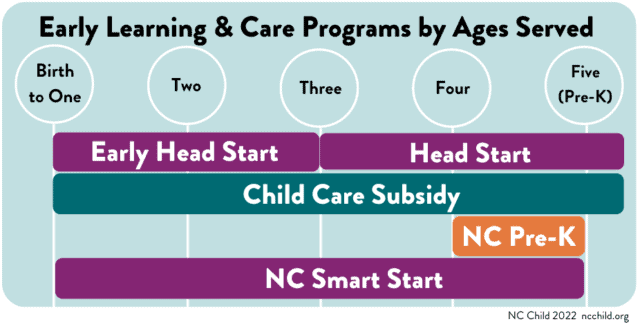Every year, tens of thousands of young children from low-income families benefit from North Carolina’s early learning and care programs. This system supports the care, education, and healthy development of children living in poverty, prioritizing parental choice and children’s individual needs. Unfortunately, due to funding rates and levels, the programs only reach a fraction of eligible children—putting child care and early learning out of reach for thousands of families who want to work and support their children.
Child Care Subsidy
What it does
Child care subsidy program for low-income families with children ages 0-5 (children ages 6-13 may receive care outside school hours).
Who it serves
Children from families who are working or in school, earning below 85% of the state median income. Also serves other special populations.
Federal program
Child Care Development Block Grant, plus state matching & maintenance of effort funds. Some Temporary Aid for Needy Families (TANF) funds for eligible children. Below budget does not include recent federal pandemic relief funds.
Budget: $403M FY 2020-211
17% of children under 6 served2
Head Start and Early Head Start
What it does
Comprehensive early learning, health, nutrition support services to children birth to age five who are living in poverty.
Who it serves
Families earning below the federal poverty line, families experiencing homelessness, children with disabilities, children in foster care.
Federal program
Head Start and Early Head Start
Budget: $242M FY 2021-223
Head Start: 19% of eligible children served4
Early Head Start: 6% of eligible children served5
Pre-K6
What it does
Early learning program to enhance school readiness, available during the school year / during school hours.
Who it serves
Four-year-old children from families with income at or below 75% State Median Income (SMI), or other documented categories regardless of income including: military status, developmental disability, chronic health condition, Limited English Proficiency.
State program
NC Education Lottery revenue
Supplement: federal TANF funds, CARES funds, and state general fund
Budget: $185M FY 2020-21
51% of eligible children served7
Smart Start
What it does
The Smart Start network is a public/private partnership comprised of 75 local partnership organizations and the North Carolina Partnership for Children.8
Created in 1993, Smart Smart helps parents pay for child care, improves the quality of early care and education programs, promotes children’s health and development, and provides family support.9
Who it serves
Children birth to 5 in all 100 counties
State program
State general fund
Budget: $154M FY 2020-21
25% of eligible children served9

Footnotes & Sources
1 Office of State Budget & Management (2020)
2 Think Babies Alliance NC (2021)
3 National Head Start Association (2022)
4, 5 National Head Start Association (2020)
6 Division of Child Development and Early Education (2022)
7 myFutureNC (2021)
8,9 Smart Start (2022)
National Institute for Early Education Research
Download the fact sheet
